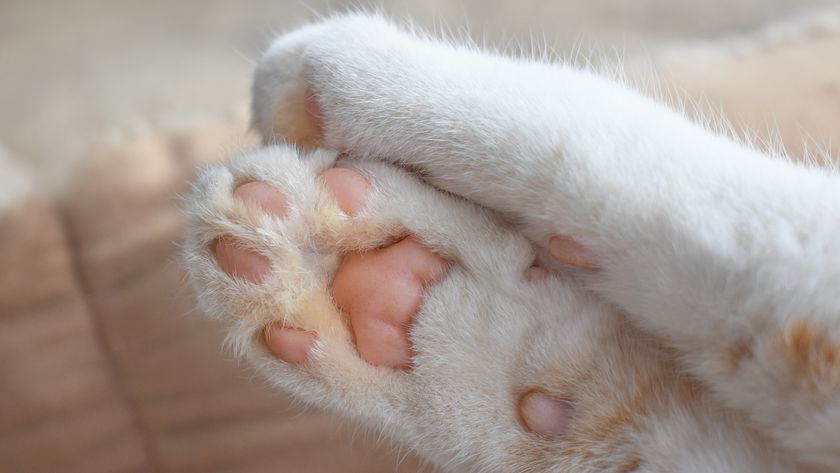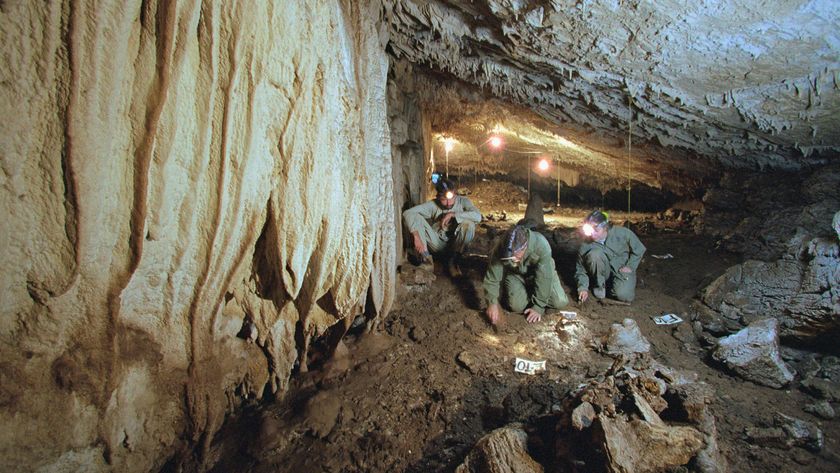Cheetahs: Earth's fastest land animals
Their acceleration rivals that of the world's fastest luxury sports cars.
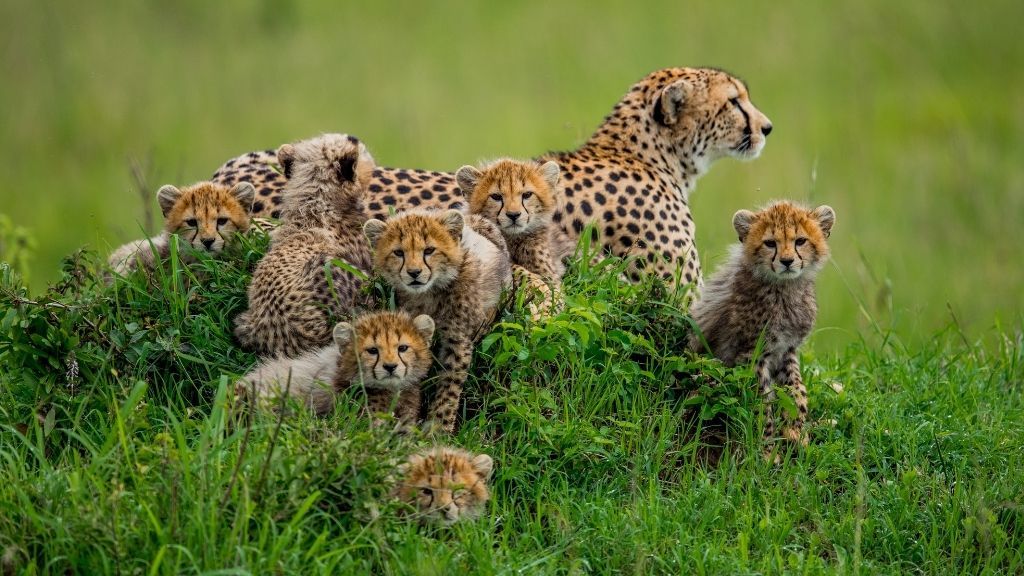
Known as the fastest land animals, cheetahs (Acinonyx jubatus) are members of the big cat family, which includes tigers, jaguars, lions, leopards, snow leopards and pumas. Their name comes from the Hindi word "chita," which means "spotted one," according to the book "Cheetahs: Biology and Conservation" (Elsevier, 2018).
With aerodynamic bodies, long legs, and blunt, semi-retractable claws, cheetahs are formidable carnivores that can sprint at speeds of 60 to 70 mph (96 to 112 km/h), according to the Smithsonian's National Zoo & Conservation Biology Institute.
What do cheetahs look like?
Adult cheetahs are, on average, 2.5 feet (0.8 meter) tall at the shoulder and up to 5 feet (1.5 m) long from head to rump, with their tails adding another 26 to 33 inches (66 to 84 centimeters). Typically, these large cats weigh between 75 and 140 pounds (34 to 64 kilograms), according to the Smithsonian.
Like leopards (Panthera pardus) and jaguars (Panthera onca), cheetahs have black spots scattered across their tan coats. But whereas leopard and jaguar spots are arranged in rosette (rose-like) patterns, cheetahs' spots are solid and fairly uniform in size, and are evenly distributed across the whole body, except for the white throat and belly, the Smithsonian notes. Cheetahs' spotted coats help them blend into the environment when resting, stalking prey and hiding from predators. Much like human fingerprints, these markings are unique to each cat.
Cheetahs also have signature black "tear stains" on their faces — one trailing from the inner corner of each eye, down to the mouth.
How fast do cheetahs run?
Cheetahs' long, slender bodies; powerful legs; and flexible spines enable them to fully stretch their bodies when they sprint and to cover significant ground — around 20 to 22 feet (6 to 6.7 m) per stride, according to the San Diego Zoo.
Cheetahs have been known to accelerate from 0 to 45 mph (72 km/h) in just 2.5 seconds, according to the Smithsonian. For comparison, the fastest cars in the world can accelerate from 0 to 60 mph (97 km/h) in 3.5 seconds, according to Consumer Reports. As noted by Guinness World Records, the peak speed of the fastest human on Earth, Usain Bolt, was 27.34 mph (44 km/h), which he achieved in a race in 2009. That means it's impossible for a person to outrun a cheetah on foot.
Related: The world's fastest animals
Kingdom: Animalia
Phylum: Chordata
Class: Mammalia
Order: Carnivora
Family: Felidae
Genus and species: Acinonyx jubatus
Cheetahs can execute quick turns even while in midair, thanks to their long tails, which counter their body weight, according to the San Diego Zoo. Their semi-retractable claws, which are more dog-like than cat-like, provide great traction during sprints and sudden changes in direction.
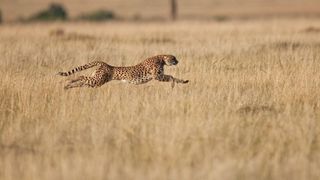
Where do cheetahs live?
Cheetahs are native to Africa and Asia, although the Asiatic cheetah (Acinonyx jubatus venaticus) has become all but extinct, according to The Times of Israel.
According to the African Wildlife Foundation (AWF), cheetahs currently inhabit only about 10% of their historic range. The animals are now found primarily in North Africa, the Sahel (the region between the Sahara desert and the savanna of Sudan), East Africa (Kenya and Tanzania) and southern Africa (Namibia and Botswana), according to the Smithsonian.
A small population of Asiatic cheetahs also lives in Iran, where the animals are critically endangered. In January 2022, Iranian officials reported that only a few cheetahs remained in the country, The Times of Israel reported.
Cheetahs don't have one home location where they seek shelter day in and day out. Instead, these nomadic cats have home territories or ranges — expanses of grasslands, savannas, forest land and mountainous terrain, ranging from about 5 to 370 square miles (13 to 958 square kilometers), which they regularly roam, according to the Smithsonian. When not actively hunting, they prefer to sleep and rest in tall grasses, under trees or on rocky outposts.
How do cheetahs socialize?
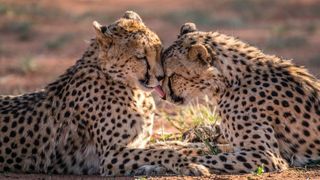
While female cheetahs tend to live alone or with their cubs, males typically live in small groups called "coalitions," which are made up of male cheetah siblings. Females socialize with males only when mating, and they raise their offspring on their own, according to the Smithsonian.
The gestation period for cheetahs is around three months, and litter sizes range from three to five cubs. Cheetah cubs weigh between 5 and 10 ounces (140 to 280 grams) when born — not much larger than newborn house cats, which typically weigh 3 to 4 ounces (90 to 110 g). Cubs are born with all their spots, as well as mane-like hair on their neck and shoulders. However, these so-called "mantles" disappear as the cubs age, according to the San Diego Zoo.
Related: Cat photo album: The life of a cheetah
When a cub is about 6 months old, its mother starts teaching it to hunt and avoid predators, such as lions, hyenas, eagles and humans. Mothers live with their cubs for about 18 months, but even under the mother's watchful eye, only about 5% of cheetah cubs survive to adulthood, according to the AWF.
The littermates that do survive tend to stay together for another six to eight months, after which the female siblings leave the group to live on their own. Male siblings tend to stick together in coalitions of two or three so that they can better protect their territories. Lone males are not common and typically do not survive long on their own, according to the San Diego Zoo.
According to the Smithsonian, male cheetahs reach sexual maturity around age 2. At that point, the coalition seeks out a new home range far away — sometimes as far as 300 miles (482 km) — from their mother's range. Male territories usually span 5 to 10 square miles (13 to 26 square km) and can extend up to 50 square miles (130 square km).
Young females typically stick closer to home, sometimes even occupying the same range as their mother, though living independently. Their home ranges are more extensive than those of males and can cover up to 370 square miles (960 square km), largely because the big cats follow the migration path of gazelles, a primary food source.
In the wild, cheetahs have average life spans of 8 to 10 years. In captivity, they can live longer — around 12 to 15 years, on average — due to human care and a lack of natural predators, the Smithsonian notes.
What do cheetahs eat?
Cheetahs are carnivores, or meat eaters, whose typical prey are small- to medium-size animals, such as birds, hares, warthogs, gazelles and young wildebeest.
During daybreak and dusk, cheetahs spend their time stalking and catching prey. Because their teeth are shorter than those of other big cats, according to the Smithsonian, cheetahs suffocate their prey by clamping down on the animal's throat with their strong jaws, rather than sinking their teeth deep into their prey's flesh.
Cheetahs typically creep up on their prey and don't initiate their chase until the targeted animal starts to flee, according to The Maryland Zoo. After catching its prey, a cheetah must rest for about 30 minutes before eating the catch; if a larger predator, like a lion, approaches before the cheetah can consume its meal, the cheetah will often abandon its catch to avoid conflict.
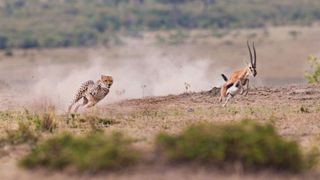
What does a cheetah sound like?
Unlike other large cats, cheetahs can't roar. But they can purr just like house cats, according to the Smithsonian.
Related: Why can't house cats roar?
Compared with other big cats — such as lions, tigers and leopards — cheetahs have a wide "vocabulary." In addition to purring, they can produce a large range of vocal cues, such as chirping (similar to a bird's chirp or dog's yelp); stuttering (a short, disconnected moan); hissing; yelping (a loud chirp that can be heard up to a mile (1.6 km) away); and an "eeaow" sound, which is similar to a house cat's meow, according to the Smithsonian.
Each vocalization seems to have a specific meaning. Various types of chirping, for example, could be a mother giving instructions to her cubs or a female trying to attract a male to mate, the Smithsonian notes.
Are cheetahs endangered?
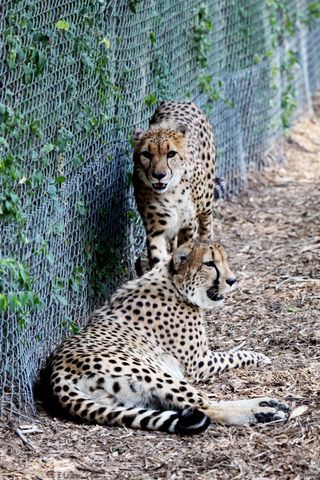
According to the International Union for Conservation of Nature's (IUCN's) Red List of Threatened Species, most cheetah subspecies are considered "vulnerable," meaning their populations are in decline and the species is likely to become endangered if the circumstances threatening its survival don't improve.
That said, based on recent estimates of wild cheetah populations, some scientists have pushed for the cheetah’s status to be changed from vulnerable to endangered, National Geographic reported. As of June 2021, there were an estimated 7,000 or so cheetahs left in the wild, BBC News reported.
According to the Smithsonian, there were at least 100,000 cheetahs living throughout Western Asia and across Africa in 1900. Now, the cats are extinct in at least 13 of their native countries and have lost as much as 90% of their original range. The largest population of cheetahs is a group of approximately 2,500 in Namibia.
According to the AWF, the cheetahs' steep population decline is tied to habitat loss, human conflict, and illegal trade and poaching.
Conservation efforts are underway to help the population rebound. Groups such as the AWF and the Cheetah Conservation Fund work locally with communities near cheetah populations to create sustainable solutions for agriculture and population growth, so that both the cats and humans have sufficient space. Protected areas and wildlife parks, such as the Cheetah Experience in South Africa, protect cheetahs as their habitats are taken away.
Captive breeding programs at zoos such as the San Diego Zoo and the Smithsonian's National Zoo are working to help the cheetah population grow. The programs are also striving to overcome the lack of genetic variation within wild cheetah populations.
Additional resources and readings
- Which is faster: a cheetah, or a Tyrannosaurus rex? Find out with SciShow.
- Learn exactly how cheetahs run so fast, with Animal Planet.
- Read about India's effort to reintroduce cheetahs to the subcontinent in The Atlantic.
Bibliography
AFP. (2022, January 10). Iran says only 12 asiatic cheetahs left in the country. The Times of Israel. https://www.timesofisrael.com/iran-says-only-12-asiatic-cheetahs-left-in-the-country/
African Wildlife Foundation. (n.d.). Cheetah. African Wildlife Foundation. Retrieved February 17, 2022, from https://www.awf.org/wildlife-conservation/cheetah
Bartlett, J. S. (2021, November 10). Cars with the fastest acceleration in Consumer Reports' tests. Consumer Reports. https://www.consumerreports.org/cars-best-and-worst-car-acceleration/
Biswas, S. (2021, June 6). Cheetah: The world's fastest cat is returning to India. BBC News. Retrieved February 24, 2022, from https://www.bbc.com/news/world-asia-india-57313563
Guinness World Records. (n.d.). Superlatives: Fastest. Retrieved February 22, 2022, from https://www.guinnessworldrecords.com/products/books/superlatives/fastest
International Union for Conservation of Nature (IUCN). (n.d.). Cheetah. IUCN Red List of Threatened Species. Retrieved February 18, 2022, from https://www.iucnredlist.org/species/219/50649567
Marker, L., Boast, L. K., Schmidt-Küntzel A., & Nyhus, P. J. (2018). Cheetahs: Biology and conservation (Ser. Biodiversity of World: Conservation from Genes to Landscapes). Elsevier, Academic Press. https://www.sciencedirect.com/book/9780128040881/cheetahs-biology-and-conservation#book-description
The Maryland Zoo. (n.d.). Cheetah. The Maryland Zoo. Retrieved February 24, 2022, from https://www.marylandzoo.org/animal/cheetah/
Petri, A. E. (2017, November 12). Cheetahs are dangerously close to extinction. National Geographic. Retrieved February 24, 2022, from https://www.nationalgeographic.co.uk/animals/cheetahs-are-dangerously-close-extinction
San Diego Zoo. (n.d.). Cheetah. San Diego Zoo Wildlife Alliance Animals & Plants. Retrieved February 17, 2022, from https://animals.sandiegozoo.org/animals/cheetah
Smithsonian's National Zoo & Conservation Biology Institute. (n.d.). Cheetah. Smithsonian's National Zoo & Conservation Biology Institute. Retrieved February 17, 2022, from https://nationalzoo.si.edu/animals/cheetah
The page was last updated on Feb. 25, 2022, by Live Science staff writer Nicoletta Lanese.
Originally published on Live Science.
Sign up for the Live Science daily newsletter now
Get the world’s most fascinating discoveries delivered straight to your inbox.
Tiffany Means is a meteorologist turned science writer based in the Blue Ridge mountains of North Carolina. Her work has appeared in Yale Climate Connections, The Farmers' Almanac, and other publications. Tiffany has a bachelor's degree in atmospheric science from the University of North Carolina, Asheville, and she is earning a master's in science writing at Johns Hopkins University.
- Nicoletta LaneseChannel Editor, Health
- Alina BradfordLive Science Contributor


